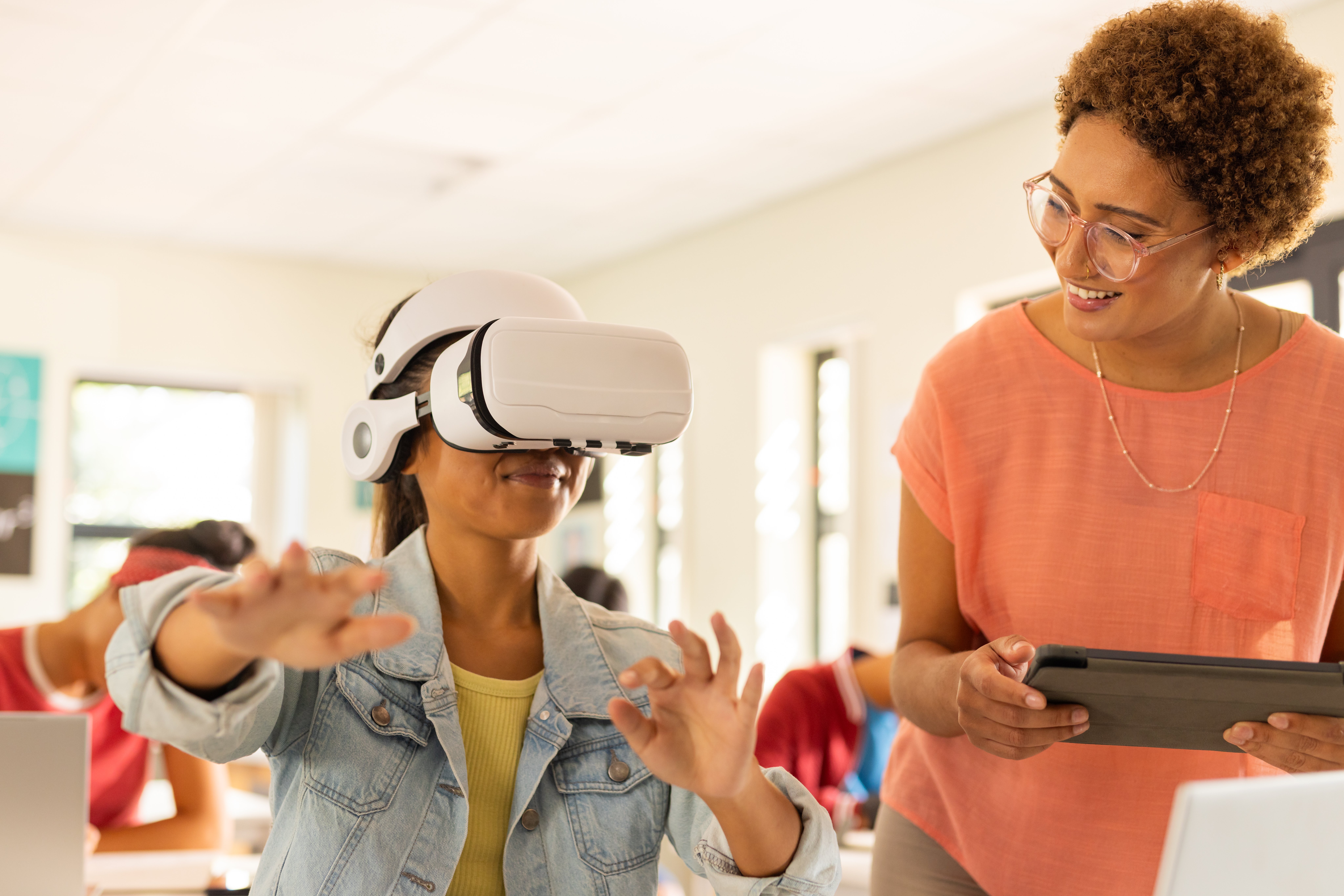- Classroom Integration and Simulation-Based Learning
- Advantages and Disadvantages of Virtual Reality in Education
- Classroom Virtual Reality and the Role of Teachers
- How VR Supports Different School Subjects
- Virtual Reality and Special Educational Needs (SEN)
- The Future of Virtual Reality and Education
Introduction: Virtual Reality Technology
Virtual reality technology is reshaping the education system by offering interactive learning through computer-generated environments. These virtual environments allow students to explore abstract ideas, historical sites, or even the human body, enhancing the learning process across all levels, from primary to higher education.
In this evolving digital age, adopting virtual reality and other emerging technologies like augmented reality is enabling teachers to rethink traditional teaching methods. The immersive nature of VR lessons helps provide students with richer, more engaging learning experiences while supporting better academic performance.
🔑 Key Takeaways: Virtual Reality in Education (UK 2025)
Virtual reality in education is rapidly advancing, transforming classrooms with immersive experiences and simulation-based learning. From VR field trips to virtual laboratories, schools are rethinking how they teach complex concepts in a safe and controlled environment.
- The UK VR market is booming – projected to grow from $1.8B in 2024 to $6B by 2033.
- VR adoption in UK schools rose by 35% in 2024, driven by more affordable headsets.
- 93% of teachers believe VR enhances teaching quality and boosts student engagement.
- Simulation-based assessments are gaining traction, with 74% of teachers supporting their use to evaluate real-world skills.
- VR training is 4x faster and 52% cheaper than traditional training at scale (PwC).
- Only 63% of IT leads say VR headsets are ‘fit for purpose’, revealing ongoing tech and infrastructure gaps.
- VR lesson plans increased engagement by 30% in UK classrooms in 2023.
- 44% of SEN parents see VR as essential for personalised learning, especially for neurodiverse learners.
- Teachers remain central – 59% say combining human instruction with AI/VR yields the best learning outcomes.
- Student interest in the Metaverse dropped from 80% in 2023 to 50% in 2025, while interest in AI remains steady.
To better understand how this technology is shaping education in the UK, the GoStudent Future of Education Report 2025 surveyed over 5,800 parents and students aged 10–16, including 1,000 respondents from the UK, as well as 300 teachers. This article explores the findings of that report, alongside UK-specific statistics, to assess the current state and future potential of virtual reality in education.
Classroom Integration and Simulation-Based Learning
As UK schools accelerate their digital transformation, incorporating VR and augmented reality into classrooms has become a powerful way to enhance student engagement. These tools create immersive user experiences that replicate real-life situations, helping students build both communication skills and critical thinking.
-
Simulation-based learning is becoming a preferred assessment method in UK schools.
-
Simulation-based assessments (SBAs), which are already widely used in healthcare through virtual reality scenarios and diagnostic exercises, are now entering UK classrooms. 74% of teachers believe VR-powered SBAs are an effective way to assess students’ real-life skills like decision-making and critical thinking.
-
This is part of a broader push to move beyond traditional exams, which 62% of parents believe no longer reflect true student potential.
-
-
The introduction of affordable educational VR headsets has led to a 35% increase in VR adoption in UK schools in 2024.
According to the UK Department for Education’s 2022–23 Technology in Schools Survey:
- Only 63% of IT leads said VR/AR headsets were “fit for purpose.”
- By contrast, 95% rated laptops, 93% tablets, and 88% interactive whiteboards as suitable for classroom use.
- The lower rating for VR highlights the technical and training challenges schools still face.
The lower rating for VR highlights the technical and training challenges schools still face. Access is also uneven: just 15% of non-fee-paying schools and 20% of fee-paying schools currently have VR headsets available for students.
This shift reflects how digital tools and virtual environments are transforming education. VR equipment like headsets and interactive simulations enables a new way to align learning objectives with practical, experience-based teaching.
These technologies also support vocational training and medical training, where learners can practise skills in a controlled environment before applying them in the real world.
(Source: GoStudent Education Report 2025, GOV.UK, Global Growth Insights)
Advantages and Disadvantages of Virtual Reality in Education
As the education sector explores how to modernise the learning experience, VR education has shown its power to transform how students interact with educational content. Through virtual objects, virtual characters, and immersive scenarios, virtual reality learning helps students visualise complex theories and develop real-world capabilities.
PwC’s study revealed that VR training became 52% cheaper than classroom training once scaled to 3,000 learners, making it highly cost-effective for large cohorts. Additionally, 75% of participants in VR courses experienced a "wake-up call" realising their inclusivity shortcomings, showcasing VR's impact on empathy and awareness.
- Were 4x faster to train than in classroom settings
- Felt 3.75x more emotionally connected to the material
- Were 4x more focused than e-learning peers
- Showed a 40% confidence boost in applying new skills
Advantages
- VR lesson plan libraries also enhanced interactive classroom engagement by 30% in 2023.
(Source: - VR can improve student understanding, attainment, and even increase test scores by up to 20%.
- Introducing VR can prompt students to stay more cognitively engaged and enhance knowledge and research needs.
- Interactive Learning: Enhances engagement and understanding
- Improved Retention: Stronger memory through multisensory experiences
- Personalised Education: Adapts to student needs, especially helpful for SEN students
- Skill Development: Prepares students with real-world skills and emotional awareness
Disadvantages
- Cost: Equipment like VR headsets can be expensive
- Technical Training: Teachers need support to use VR effectively
- Access Inequality: Not all schools have the infrastructure to support VR
- Over-reliance Risk: As noted in the GoStudent Report, 54% of parents worry students may become too reliant on AI tools
At the same time, proper integration of VR technologies requires careful planning, teacher training, and consistent access to technical infrastructure. Without these, the benefits of VR learning can remain out of reach, especially in under-resourced schools.
(Sources: GoStudent Education Report 2025, NIH, ClassVR, PwC UK, Global Growth Insights)
Classroom Virtual Reality and the Role of Teachers
Even in the most sophisticated virtual world, teachers remain the cornerstone of effective education. Virtual reality tools can enrich lessons, but it’s the teacher who translates immersive content into deeper understanding, guiding students, personalising support, and aligning lessons with core learning outcomes.
A study found that 93% of UK teachers believe VR is beneficial for teaching in classrooms.
Teachers remain central in VR-enhanced classrooms. While VR can deliver content and simulate scenarios, it’s the teachers who guide discussions, foster emotional intelligence, and personalise follow-ups.
VR technology has the potential to revolutionise teacher education by creating real-time classroom scenarios and innovative virtual teaching environments.
According to GoStudent’s research:
- 59% of UK teachers believe the best learning outcomes happen when AI/VR tools are paired with human teaching
- 74% of teachers are not yet trained in AI tools, highlighting the urgent need for professional development
VR in education doesn’t replace teachers, it enhances them. When used alongside human instruction, VR technology creates new pathways for fostering empathy, nurturing intrinsic motivation, and building stronger engagement in the classroom.
(Sources: GoStudent Education Report 2025, MATSH, ITARI)
How VR Supports Different School Subjects
Science: In subjects like physics, biology, and chemistry students can run virtual experiments in safe and controlled environments, explore the human body in 3D, or simulate space missions, making complex concepts more accessible and engaging.
Geography: With virtual field trips, learners explore volcanoes, rainforests, and urban landscapes, bringing the physical environment into the classroom.
History: VR allows students to walk through historical sites, interact with virtual characters, and relive key events, fostering empathy and deeper understanding.
Languages: Whether learning English, Spanish, or another modern language, students can practise conversations in immersive environments like cafés or airports, helping build communication skills and confidence through interactive learning.
Maths: VR helps visualise 3D shapes, graphs, and symmetry, supporting problem-solving and boosting engagement with abstract ideas.
Art & Design: Learners create digital art in a virtual environment, enhancing creativity and introducing them to modern digital technologies.
Virtual Reality and Special Educational Needs (SEN)
For students with learning difficulties, virtual reality education offers adaptive, personalised support. Through immersive learning experiences, SEN students can progress at their own pace, revisit difficult content, and thrive in educational settings designed to reduce overwhelm.
For students with SEN, VR provides an alternative route to learning:
- Sensory Control: Environments can be adjusted for noise and visuals
- Repeatable Lessons: Students can repeat experiences until they’re confident
- Individual Pace: VR allows each learner to progress at a comfortable speed
44% of UK parents of SEN students believe AI and VR tools can deliver essential personalised support.
Whether through mobile devices or headsets, VR provides an inclusive digital learning environment that gives every child the chance to succeed. These interactive learning tools are helping the education system become more responsive to diverse learner needs.
(Source: GoStudent Education Report 2025)
The Future of Virtual Reality and Education
Looking ahead, VR learning is expected to play a pivotal role in bridging gaps between theory and practice. Whether in science education, vocational training, or personalised instruction, the immersive nature of VR experiences allows students to interact with content in ways previously impossible within the physical environment of a classroom.
VR and AI aren’t just trends, they’re shaping the future of UK education:
- 50% of UK teachers say children will need access to generative AI tools within two years
- 46% of parents support the use of virtual tutors
- 21% of students have already used AI to help pass exams, indicating digital learning is becoming mainstream
-
Learning Techniques Children Have Engaged With
- 48% – Digital learning apps
- 26% – AI teachers and tutors
- 21% – Metaverse and VR
- 21% – Virtual reality
-
Trends in AI and Metaverse Interest Among Students
- 53% of students hope to use AI in their learning (compared to 54% in 2024)
- 80% of students were interested in the Metaverse in 2023
- 50% of students are interested in the Metaverse in 2025
The immersive VR market in the UK is expected to reach USD 5.25 billion by 2030, growing at a CAGR of 27.2%.
This expansion of educational technology highlights the growing influence of digital technologies on student development, teacher workflows, and national curriculum goals. As more institutions invest in VR headsets and related tools, the next generation of learners will grow up with virtual field trips, real-time feedback, and immersive assessments as part of their daily routine.
(Source: GoStudent Education Report 2025, Grand View Research)
Conclusion
The rise of virtual reality in education marks a turning point in how we teach, learn, and grow. By blending immersive experiences with traditional instruction, schools can create an inclusive, effective, and future-ready learning environment. From outer space to historical sites, virtual reality technology lets students explore the world without leaving the classroom.
Yet, to fully unlock the power of VR tools in the education system, we must address access, training, and infrastructure challenges head-on. With proper training and strategic investment, VR in education can shift from novelty to necessity, redefining what it means to learn in the digital age.
To explore how AI in education and other digital innovations are shaping the future of learning, check out the GoStudent Future of Education Report.



.jpg?upsize=true&upscale=true&width=100&height=100&name=math-square-root%20(1).jpg)


